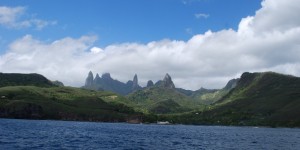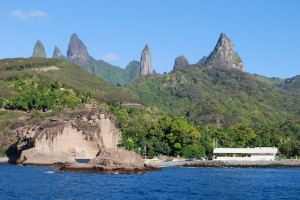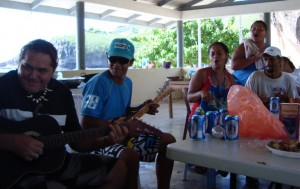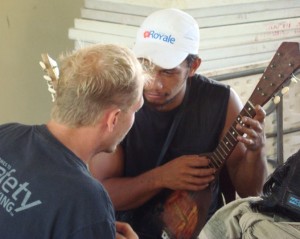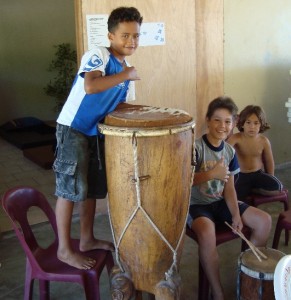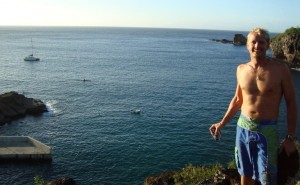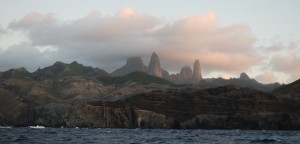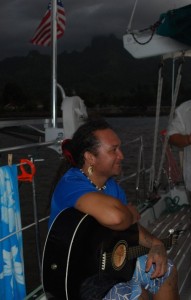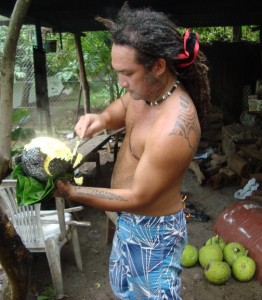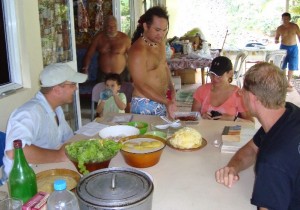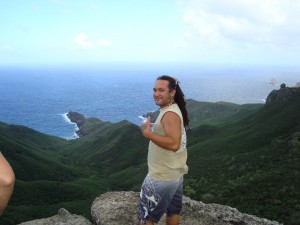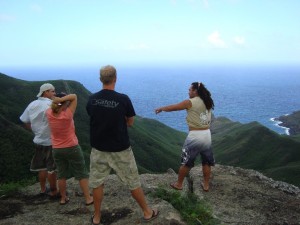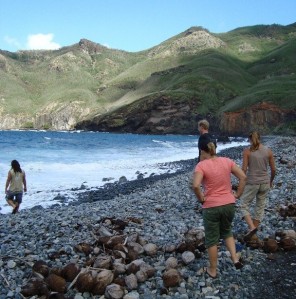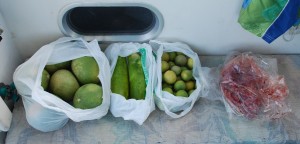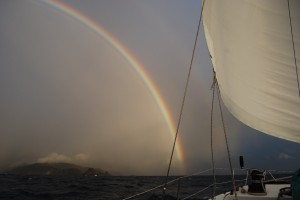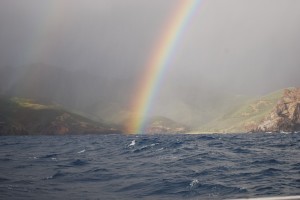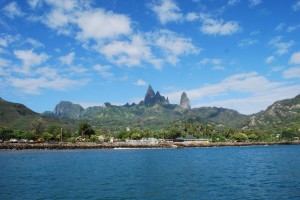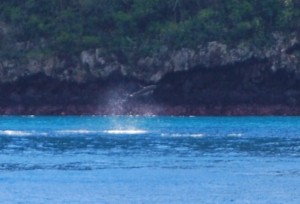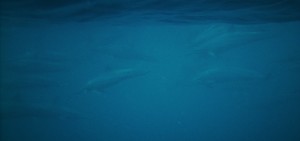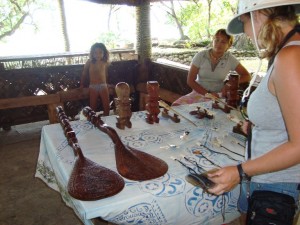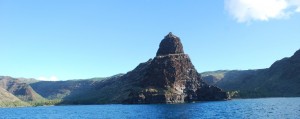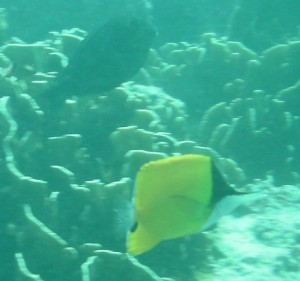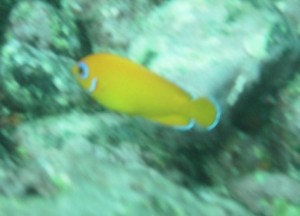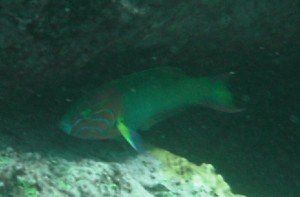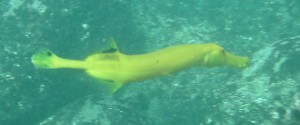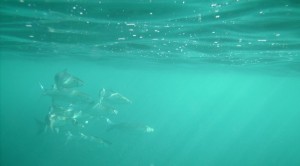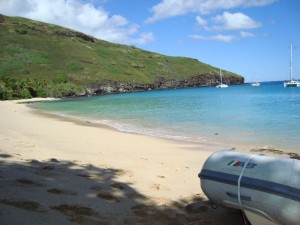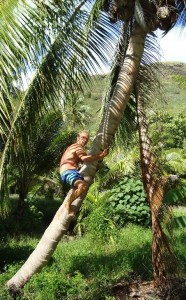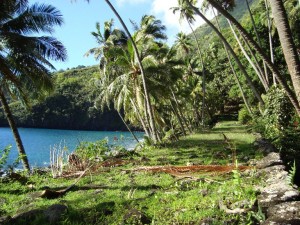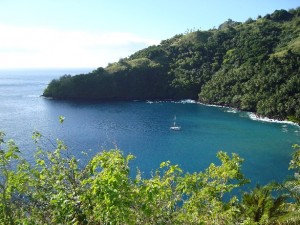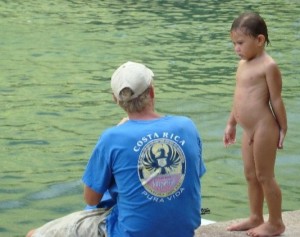We arrived at Hakahetau Bay around 11 a.m. and found that we had yet another bay to ourselves. Looking ashore, we could see each of the spires sticking up out of the lush vegetation, and a few buildings such as a church, an open-air public building, and a house or two were visible as well. After getting situated and having lunch, Dallas and I took the dinghy ashore to check out what was happening in the public building, where it sounded as though there was live music. (Wes and Tiff stayed behind to work on laundry, photo-cropping, etc.) Indeed, when we got ashore (Dallas had to swim from where the dinghy was moored but enjoyed it thoroughly), we found about 15 adults young and old around a long table singing their hearts out. They were accompanied by 2 guitars, at least 3 ukuleles, and a pahu (drum).
We approached the group and stood off to the side, expecting to do our usual fly-on-the-wall routine, but instead, a young, pretty woman approached and asked in very clear French if we had just arrived and if we would like a beer. I was expecting her to sell us the beer, but she just handed us a couple of cold cans of Hinano with a smile. A couple of minutes later, a young man with no shirt, big muscles and tattoos, and quite a few beers under his belt (figuratively speaking) approached and led me (and Dallas by default) to the head of the table where he was sitting. Now he was not a person with whom either Dallas or I were too interested in conversing (he was having a hard time communicating in any language…), but he definitely got us into the heart of the community’s activity. Minutes later, Dallas found himself on the receiving end of a ukulele lesson!
Since there were only three chords used in most of the traditional Marquesan and popular French songs (e.g., Que Sera, Sera) that they were singing, (and one of these chords requires no fingers on the frets), Dallas (being Dallas) was able to pick up the basic chords after a couple of songs. The real challenge was to attempt to strum as they did, with a speed and rhythm so lively that it would almost seem not to fit with the island culture.
We learned that the event at the public building was in honor of the children, as they had just completed an academic year. Many of the older ones could be seen playing volleyball next to the public building. The younger ones tended to watch but came into visit the adults intermittently to seek assistance, play the drum, or get me to take their picture with the digital camera. For the most part, it seemed that the children supervised themselves (the youngest watched by those slightly older, etc.), but later in the afternoon, the elementary teacher (called “the mother of the village”) gathered and assisted them in leading a few of the songs. Each of the children grabbed an instrument or sang and seemed to really enjoy taking part. One of the young boys in particular was remarkable for the way he beat a very large pahu and chanted in a voice much lower than one would expect from such a little guy. His Marquesan roots were apparent, as they were among all those present.
We were very impressed with the community spirit and hospitality of this little village of 200. The inhabitants seemed very close but extended this same attitude of friendship to us, perfect strangers. They seemed not to judge those within the group, from the very drunk guy that they eventually told to go to bed, to the effeminate male adolescents, to the loners that skipped the party to practice circling their outriggers in the bay. The only threatening words or actions that I observed were from the children who, in the absence of parental supervision, displayed their “pecking order” by taking the instruments of those younger or smaller.
Before heading back to the boat, Dallas and I climbed up some volcanic rock (which, incidentally, is quite easy to climb) to an excellent vista of the village and the boat in the bay. We had a pretty good view of a home with many goats in a unique sort of pen. Rather than having a fence on all sides as an enclosure, it was surrounded on two sides by steep rising cliffs and on a third side by the drop of another steep cliff, all part of the same large rock structure! I imagine that’s even more effective than barbed wire!
Back on the boat, we enjoyed a glass of wine with Wes and Tiff. It was the last of the bottles of $2 Clos that we purchased in Panama. If we ever write a cruising guide, we are going to encourage people to buy several cases, as it’s about 1/5 of the price of the wine here (and throughout French Polynesia, we are told). Wes then treated us to a slide show of some of the photos (cropped and captioned) that we have taken here in the Marquesas…let’s just say that you all are in for a treat as well!
Today we pulled anchor and motored several miles farther west to check out the lovely Hakamaii Bay. On the way there, we hosted another dolphin convention; evidently they are really drawn to the purr of the diesel. This time there were only about 25 in attendance, but Dallas managed to get a few photos (more like 200, pared down to 65!).
We had heard great things about Hakamaii Bay, but it was not a good anchorage (too close to the rocky shore), so we chose just to stop for a couple of hours to check it out. Our cruising guide suggested that rather than taking the dinghy ashore, it was best to call in for a local outrigger, but Dallas and I took the dinghy anyway and had no problem pulling it up onto the rocks. Again we found ourselves in a beautiful village of friendly people. There was a river running through the center of town with many fruit trees growing alongside, and we stopped to put our feet in the cool water. We saw many villagers sitting on front stoops or working on their houses, and they greeted us with a wave and a “Kaoha” or “Bonjour.” (The older adults seem to prefer the Marquesan hello, while the young people use the French.)
Before heading back to the boat, we stopped to watch 30 or so children, most of whom were playing soccer on a very small, concrete field just above the beach. (The soccer ball frequently had to be retrieved from the water.) The children were dressed in popular, though surely outdated, American beachwear such as Billabong. However, tennis shoes seem to be a luxury had by only a few. Most of the soccer players were barefoot or wore clear plastic, jelly-shoe sandals reminiscent of those that were so popular in the U.S. (with the girls anyway) in the 1980’s. I was glad to see that unlike the Marquesas of the past, where it was often an obligatory rite of passage for young adolescents to get tattoos (at the age of 12 for girls, 14 for boys), only some of the oldest appeared to have them.
In the interest of giving you a realistic portrayal of the cruising life (lest one should envision nothing but rainbows and cocktails) I should also share with you what we did on Saturday…nothing, really. I awoke with a full-body heat rash which, combined with my 200 or so itchy no-no bites, rendered me a big, cranky, splotchy mess. I spent most of the day in a prostrate position and was relieved that the rest of the crew shared my desire to stay put for a day.
We are now back in Hakahau Bay and looking forward to watching our friend Moana perform traditional Marquesan dance in the morning before saying good-bye to Ua Pou.
Because we haven’t been able to post a picture of Moana, I’ll try a quick description. He’s 32, no more than 5′ 8″, strong, athletic, and stocky. He has dreadlocks that come below his shoulders that he usually wears pulled back in a bunch, and a large prized ear-ring with three long, curved sharks teeth that he received as payment for a traditional Marquesan tattoo (one of his jobs is as a local traditional tattoo artist). He has a large, round face that is tattooed a bit on the left side and is almost always smiling or laughing. When he’s hanging out with us, he’s often cracking jokes, telling stories, or answering our questions about the island. He’s also an accomplished traditional dancer who dances as part of the local group that entertains the boat with tourists. He was selected along with two other guys and one girl to travel to France to represent the Marquesas for a month as part of an international dance exhibition/instruction project (when is the last time you heard of the US government flying in dancers from Guam, Puerto Rico, etc. for a cultural exchange?). He was proud of that but didn’t care much for France, where he felt that people live a far too rushed, hurried, scheduled, and work-oriented lifestyle. (We tried to explain that people from the US often feel the French are lazy lay-abouts, but he wasn’t impressed).
After reading Herman Melville’s “Typee” about his time as a deserter/captive of the Marquesan tribe of the Tai Pi valley in Nuku Hiva, I was anxious to try their traditional “poi poi” (Melville) / “Popoi” (po-POI as we’ve heard it) dish made of fermented breadfruit. To our delight, Moana invited us over for a traditional lunch (the word kai-kai is associated with good food and meals of this sort) with his family yesterday. Lunch required 7 coconuts, a chicken, plenty of breadfruit, and at least a couple fish. About 30 minutes after we arrived we found the table covered with: chicken with coconut milk and cucumber (Moana made a point of letting us know that this was not a “store chicken” from a package, it had evidently met its end earlier in the morning), poisson cru (fresh fish poached in lime juice with coconut milk as well), a bowl of raw fish, popoi (sort of like a thick, bitter-tasting yellow pudding), KAA-kuu (breadfruit worked into the consistency of a very thick dough and then covered in a bath of coconut milk), uru (I think this is just the Marquesan word for breadfruit, but as a dish it appeared to simply be cooked breadfruit), fresh bananas covered with some sort of brown sauce, banana fritters made of bananas mixed with flour and fried, and salad with excellent homemade dressing (just for Dallas the vegetarian). Quite a kai-kai indeed. Moana and his parents prepared the food, and some of his extended family were there to enjoy it with us. Apparently the tradition in the Marquesas is for the guests and children to eat their fill first and then for the host adults to have a turn at the table. This is definitely not the arrangement we would have preferred, but it is the custom so we obliged.
We talked for a while after lunch, and then we got a great surprise. Moana borrowed his brother’s truck to take an Air Tahiti plane ticket to his sister in Ho Hoi and invited us to come along. Ho Hoi is a valley on the east side of the island that is too exposed to visit by boat. The population there seems to be even smaller than Hapatoni. Like Hapatoni, it is too small to have a store, but does have a new small school that Moana has been helping to build. The drive through the mountains was spectacular. We first stopped the truck when Moana recognized one of his older brothers riding in the bed of an approaching truck. He lives in Ho Hoi and was on his way to Hakahau for tonight’s festivities but jumped into the bed of our truck after a few words were exchanged in Marquesan. Our next stop was a turn-out overlooking the valley between Hakahau and Ho Hoi. I can’t recall the name, but it started with Haka (which is also the name of a traditional island dance done at weddings, etc.) and Moana referred to it as the valley of the kings. It was a beautiful valley, especially when viewed from high up on the side of the mountain. Apparently important chiefs lived here at the time that missionaries began arriving. Moana’s version of the valley’s history went something like this, “Before, many chiefs live here. When missionaries come, church, many prayer, ugh. Chiefs say OK, we go to Hakahau, take people to Hakahau.” (Apparently tired by the missionaries, the chiefs moved the people to the next valley.) “Before that, when missionaries come, we eat them.” (He smiles and laughs at the fate of the previous missionaries). Not being something traditionally Marquesan, Moana is not a fan of Western religion, although his parents and at least one of his brothers are devout Catholics.
The next stop along the way was “the viewpoint”. I’ll try to describe it, but eventually you’ll get to see a couple pictures. We didn’t know we were going, so we only had the small camera, which turned out to be quite a shame. We stopped the truck by the side of the road and followed a small foot path for 50-100 feet until it ended on a sort of U-shaped ledge of large rocks that jutted out over the edge of a large valley maybe 1000 feet below. The tradewinds off of the Pacific were blowing up the mountain at 25-30 knots, and it felt as though if they were to stop blowing, you might be at risk of falling off the ledge. I’m not generally bothered too much by heights, but to be perched on a ledge 1000 feet or so above the valley floor with a strong wind blowing by definitely had a physiological effect.
The island of Ua Pou, like the other inhabited islands of the Marquesas, is made of large volcanic mountains with valleys between the peaks that are in the middle of the island and the high ridges that radiate outward from the peaks to the ocean or along the “backbone” of a longer islands. There is some variation, but generally, each valley has a bay, and depending on the difficulty of reaching the next valley, it seems the people of each valley were sort of a separate tribe in the old days. The steep ridge to the right of this valley was topped by two very large and round rock formations lightly covered with brush. Behind the ledge to our left was a sheer cliff dropping hundreds of feet that was formed more or less into three large shapes. The ridge to our left was just as steep as the one to the right and both stretched out into the Pacific, where they bordered a cliff-lined bay. Moana told us a story about how he and a friend had once come to this bay from the neighboring bay of Ho Hoi to go fishing and were unable to return due to the rough sea state. Instead, they walked up this large valley, caught and killed five wild chickens on the way, and returned to Ho Hoi by hiking over the ridge. We were in no hurry to leave the vista, but eventually we headed on to Ho Hoi.
After a short stop at Moana’s sister’s house, we headed to the beach. The beach was made of rocks with no sand. Our ears were filled by the familiar crackling sound of the ocean surf receding from the rocks on the beach, the sound of the tradewind-driven waves crashing on the rocks, and the sound of the trades themselves as there were accelerated by the narrow bay and steep mountainside behind. I don’t know if this is the case everywhere here in the Marquesas, but we noticed for the first time that the rocks on the beach that seem to appear a chalky gray when dry and a deep black when wet are actually many rocks of different colors that are only visible when wet. There were deep green ones, light red and dark red ones, and yellowish ones. At the south edge of the choppy bay was a group half a dozen or so men that looked like fathers and sons. They were cutting up and eating raw fish and had apparently just returned from fishing in the outrigger canoes that were resting nearby.
After a half an hour or so on the beach, we got back into the truck and headed back to Hakahau for Friday night’s festivities. Apparently this is still an extension of the Bastille Day celebrations which are more or less a month long. Tonight’s attraction would be traditional dancing by the local women and girls whom we had seen practicing in an open-air public building on the beach across from the boat. Moana wasn’t too excited as the dancing would be Tahitian-style instead of Marquesan, but we wanted to see it anyway, so we enjoyed a nice dinner on Tim while we watched the dancing. The local restaurants here are the same style as the ones in Atuona — there are half a dozen or so, mostly open-air restaurants, usually with 2-3 inside a tin-roofed “building”. The ground serves as the floor, and there are simply tables with decorative tablecloths and plastic chairs. The restaurants are arranged in a sort of large U-shape, so that a public event can occur that is generally visible to anyone in any of the restaurants. Here in Hakahau, most of the open area was covered by a tent where the women and girls danced to recorded music. The dancing here seems to have suffered a bit from the years of being banned and the competing interests of a more modern existence, but it was interesting nonetheless. The youngest group of girls was about 12 and the largest group included middle-aged women.
There are a lot of good Moana quotes from the day, but I’ll try to relate a few them. He explained that it is OK on Ua Pou to drive home after a party because one can drive slowly, at a speed commensurate with one’s ability at the time. Referring to the gears of a manual transmission, he said, “Drive home is OK. Not drive fast. Go 1, go 2. Aahhhh yes. It’s good. It’s OK.”
He had a lot to say about the transition from a sustenance existence to a buy and sell economy. It is pretty interesting to note that in the past these islands supported a fairly large population with enough surplus to sustain religious construction, priests, chiefs, and war, but now need French support to sustain even the small population that exists today. “Before,” he said, “You take (reaching out his hands as if grabbing fruit from a tree), you eat. You hungry, you take. You no take (hands under his armpits), you no eat. Take fish, take birds, hunt goat, hunt pig, take breadfruit, take coco(nut), no buy. Now, want fruit, you buy. Want fish, you buy. Want chicken, buy.” He’s not too happy with his two older nephews, who like cars and music, but won’t go hunt goats. He does feel there’s some hope for the youngest nephew in that family, though, who will go fishing and goat hunting with him.
An interesting side note to this whole conversation was his mention of the way children’s behavior had changed. In the old days, kids started supplementing the family’s food intake at a young age, especially if they were hungry for something in particular (fish, wild goat, etc.). At 8 or 9 Moana used to catch octopus bare-handed to bring home for a treat. Now the kids are dependent on food provided by the parents, and because much of the food is purchased they have no role but to be fed. Even here in the big city (pop. 1096) of Hakahau, people still have chickens, pigs, and fruit trees at home, but with occasional fairly isolated valleys, the Marquesas does make an interesting place to observe both near-sustenance and almost complete buy-sell economies.
With the steep and muddy mountain roads on the drive to and from Ho Hoi, Moana was concentrating hard on driving and a couple of times couldn’t answer a question to our satisfaction. Even with our rough French and his rough English, it often takes several attempts to state a question and to confirm that it is indeed understood by both parties. The first time this happened, he drove on, and then when a came to a bend in a road with a spot to pull over he stopped the truck, turned toward the backseat, and said, “OK, Lauren. What is the question?” There aren’t too many cultures where someone would take you on a tour across their island without expecting anything in return and then go to the trouble of pulling the truck over on a steep and muddy mountain road so they can properly answer your question. When the same thing happened again, about 10 minutes later as we were nearing town, he laughed, “Sorry Wes, I DRIVE. Haha. I DRIVE.”
Moana’s signature in our guest book includes the words “Te Henua Enana.” It’s the name for the Marquesas in the local language and means “the land of men” — Te Henua (the world) Enana (men).
We’re going to try to be here in Hakahau on Tuesday when the Ara Nui arrives from Tahiti. It’s one of the ships that serves as cargo, passenger, and tourist vessel. When it stops, the local artisans bring out their wares to sell and Moana will be doing a traditional dance for the tourists with other Marquesans and pahu (drums) at the pae pae (traditional meeting place) that we’d like to see. In the meantime, we may stay here or go visit the west side of the island.
They accepted the gift with the generosity for which the Marquesans are renowned. Without even opening the pacakge, they set about collecting things for us to take back to the boat — two of the largest cucumbers I’ve ever seen, a bag of about two dozen limes, half a dozen large pamplemousse, and a large piece of meat from a pig they had just killed that morning! Lauren asked them how many pigs they had and with a smile Eugene said, “Yesterday I had two. Today I have one.” We (mostly Lauren since she speaks a bit of French) had a nice conversation with them about their family and life. We felt pretty bad about the inequatable set of gifts we had exchanged, but when they told us they were headed to Tahiti in two weeks we didn’t feel so bad. They had been living in a house owned by Eugene’s cousin, who lives in Atuona. Eugene had done quite bit of working planting edible plants and trees, clearing brush, and generally beautifying the place, but their adopted son has Down’s Syndrome and needs to attend a special school in Tahiti, so they’re headed back to live there until his school is finished. Luckily, they have plenty of family there as well.
After finally breaking away, we enjoyed a dip in the fresh water pool and filled our water jugs. Lauren filled the jugs while I carred them back to the dinghy. Carrying 100 pounds of water over a soft sand beach is some serious exercise, but Lauren got the worst of the deal. There were swarms of no-nos (no see-ums, biting flies, etc.) that managed to get in a 100-200 bites on her back and arms before all of the jugs were full. She’s still itching.
We left for Ua Pou an hour or two before sunset and learned that our sea legs had left us. There was no puking, but Lauren and Tiff didn’t feel too well, especially after Lauren spent a couple of hours below preparing a delicious dinner.
I had the morning watch, which turned out to be good luck yet again. The winds were 20-30 knots and the sky was very overcast. The whole island of Ua Pou disappeared as we were enveloped in a rainstorm only a couple of miles from the northeast tip of the island. As the rain lessened and the sun came up over the horizon, the brightest and most complete rainbow I’ve ever seen arched over the entire island. It was brilliant and unbroken, a complete semi-circle from the southern to the northern tip of the island. With a haze of clouds still hanging over the island under the rainbow, it looked like a giant amphitheater with the rainbow as the arch of the enclosure and Ua Pou itself as the stage. As we the rainbow faded and we made our way along the north coast of the island, another pair of rainbows emerged, the brighest one only about a mile away, between the boat and the rocky coast.
The village of Hakahau is nestled in a beautiful valley with the spires of Ua Pou above it. The spires are tall sections of rock pointing up into the sky above the larger mountainside. A picture is worth a thousand words in this case, and we should have the pictures up when we get to Nuku Hiva in a few days. For now, we’re enjoying the beautiful and friendly village. We’ll be here for at least another day or so, as there is a party with traditional dancing Friday night and Saturday night and we’re anxious to see an example of Marquesan traditional dancing.
Last night, we hung out with a local named Mouna who drove us part of the way up a mountainside so we could see the bay and valley below at sunset. “Ahhh, I like my island” and “Ahhh, I like my valley,” he would say as he took in the sight.
I woke up around 6 a.m. to the sound of knocking on the boat and whistling. I thought that perhaps a Marquesan from Hapatoni village and stopped over for a visit, but instead, I found Dallas trying to communicate with several large schools of dolphins in the bay! It was a very pleasant sight, but I needed a couple more hours sleep. When I awoke, I was surprised to find them still around. Dallas was attempting to snap pictures of them jumping in the air and spinning, sometimes making 3-4 rotations before splashing down just a second or two later. It was virtually impossible to point the camera in the just the right direction at just the right time. Eventually I talked him into abandoning the effort in favor of hopping in and swimming with them. He didn’t regret it, to say the least. Dolphins in the wild are not like they are at Sea World, though. They did not seem to know what to make of us and may have even tried to avoid us, but we were still able to have a few close encounters. We could hear them talking to each other (presumably) and managed to take a few underwater pics of their sleek bodies moving in perfect sync with each other. It was very memorable.
There wasn’t much else in the water this morning except for a few fish (that disappeared as soon as we put lines in the water) and plankton. The water was thick with it, and you could see the diverse individual organisms, from the little (<1″) pieces to very long and skinny snake-looking ones. We are pretty sure that they weren’t snakes but avoided them anyway.
After our swim, Dallas, Tiff, and I jumped into the dinghy and headed back into Hapatoni village in search of the artisans. The few small powerboats and outriggers with outboard motors that we had seen the day before were gone, probably because the men of the village took them to work in one of the larger towns. We did not find any wood carvers at the workshop initially but were directed by a local to the large, open-air public building where we had seen people playing BINGO yesterday. I asked about the artisans and was told to come in, whereupon I started asking the women inside what they were up to. One woman explained in Franglais (French/English) that she was making costumes for a play that her group of 3-5 year olds were putting on for the village at the end of the month. We then noticed other women setting up a display of wooden items on two tables and walked over to find that they were doing so for our benefit. The art on display included over 50 items created from sandalwood and bone of various animals including marlin spike and pig tusk. In addition to jewelry, many items had functional or historical value. Dallas and I selected a ceremonial lance; a tiki is carved into the sandalwood handle, which is connected to the fishbone spike with the joint covered by woven strands of coconut fiber. The items ranged in value from $20 (tiki necklaces) to over $200 (large decorative wooden paddles)–more than one might expect from artisans at such a small village, but a great bargain given the quality and the probable price they will sell for in Tahiti. In addition, we were able to meet the artist (a surprisingly young man), which adds to the experience.
Since Tiffany had not yet seen Hapatoni village, we walked up the ancient road again. We passed the powerhouse for the village and noticed that since it was Monday, it was open and manned by two Marquesans. We asked them if we could take a look inside. There was a fairly large, 4-cylinder, Perkins generator that powers the entire village. Unlike Isabela Island in the Galapagos, theirs runs 24/7, so there are no electrical interruptions.
As we returned on the road next to the beach strewn with volcanic rock and white coral, we noticed something that we have been meaning to include in our blogs. On volcanic beaches, one can hear a crackling noise when the waves flow back over the rocks and out into the ocean. It’s probably one of those you-have-to-be there kind of things, but we thought it worth mentioning, as it’s unusual to those of us who are accustomed to sandy beaches.
On the way back to the dinghy, an outgoing 11-year-old girl approached us. She spoke French at just the right level of sophistication to match my conversational skills. I learned that she is on vacation from school until August 11 and enjoys it because she can just go surfing with her friends. I could have had a similar conversation with a kid on any coast. Some things are universal.
Not long after we returned to the boat, we pulled the anchor and motorsailed back to the north coast of Hiva Oa. We decided to stop at a lovely bay called Hanamenu where we are the only boat. The four of us went ashore in the dinghy to take a bath in the refreshing freshwater pool that we had read about in the cruising guide. What the guide did not mention is that there is now a family living here beside the bay. The woman was sitting outside near a fire, and I approached and introduced myself. She was very friendly and asked us to sit down with she and her husband. We learned that they had been living there with their adopted son for only 6 months (hence, they were not included in the cruising guide). They agreed that it was very tranquil there with the exception of the no-nos (although the smoke from the coconut husk fire worked to fend them off) and mosquitos. They were very kind and welcomed us to use the pool, chop wood, and anything else we might require. Apparently they are used to weekend visitors from the southside of Hiva Oa, despite that one can only arrive there by boat or horse. I am planning to take them some cookies today when we go to use the pool once again.
The cool freshwater streaming down from the mountain made for a glorious bath surrounded by mountains, palms, and wild horses, although it took some of us (Dallas) several minutes to work up the nerve to get in and immersed. The especially amusing part of the experience was that upon getting back into dinghy to return to the boat nice and clean, we took on a few waves as they pushed us back ashore and became salty once again. I think it’s inevitable, but I’m sure you don’t feel too sorry for us right about now!
Last night was incredibly quiet and serene. There were no lights whatsoever except for the multitude of stars, and no sounds except for the waves washing up on shore and crashing against the base of the cliffs that line both sides of the bay.
This morning (Tuesday) I gave Dallas a much-needed haircut (his first since Shelter Bay Marina in Panama). We are now going to take care of laundry (using the freshwater ashore) and boat tasks (e.g., cleaning up the rusty anchor chain) prior to heading off to Ua Pou, about 60 miles away. We should arrive there just after sunrise tomorrow and look forward to a spectacular view of the spire-shaped volcanic peaks.
After changing the batteries twice, the underwater camera was working just fine again, so Lauren and I jumped in and headed back to the cliffs to get some fish pictures while Wes and Tiff swam up to the beach. Taking underwater photographs when you’re still a novice free diver is a fun challenge. Unfortunately, the fish don’t understand the purpose of the endeavor and in general, the more bright and interesting-looking the fish, the more skiddish, and evasive. The problem here is that the camera needs to be much closer than a diver to “enjoy” the view. Out of 40 or so pictures, no more than half were in focus and not blurry, and there were only two that I thought were really good, although several others weren’t bad. We look forward to posting them soon.
Wes and Tiff made a scrumptious casserole for dinner incorporating leftover noodles from last night’s pasta, potatoes, corn, cream of mushroom, and cheese. It seemed like we were all in the mood for a quiet, early evening.
This morning Lauren and I rowed ashore to stock up on limes and coconuts before leaving Hanamoenoa Bay. The crew on Independence had told us they were having some Marquesans over for lunch today, so we stopped by on the way ashore to get the scoop. They were about to head over to Vaitahu (Resolution Bay) to pick them up, but we found out later that the daughter of the primary guest had cut her leg on some coral, the cut had become infected, and they’d had to take her to the hospital in Atuona, so the get-together on the beach would be only cruisers. (I think before I mentioned that the population of Atuona was 2,600, but it’s actually only 1,600 or so. Even at that size, it’s the second largest town in the Marquesas).
Hanamoenoa Bay is uninhabited, although there is a fenced-in area in the middle of the beach and a structure inside for drying copra. Copra is the dried meat of the coconut and is a primary cash crop here. In the morning, a boat with a few Marquesans came to the bay and started a fire in the copra-drying structure and left a few hours later. Anyway, after all that digression, Lauren and I ended up on the beach relatively early in the morning.
Ahh yes, one more digression. This morning during breakfast Lauren and I could see the spires of Ua Pou (65 miles away) on the clear horizon. We’ve seen a couple of pics and can’t wait to get there in a few days. Now to get back on track.
We walked along the beach and back into the woods a little bit. We picked up a few coconuts of the ground that made a sloshing sound when we shook them (still good water & meat inside) and picked 15 or 20 limes. Our stock of fresh fruit on the boat now includes a stalk of bananas hanging at the stern of the boat (bought from Alec), several pamplemousse (Alec), four coconuts (scavenged in Hanamoenoa), a pineapple (gift from the Swedes), and a bunch of limes (picked in Hanamoenoa). There’s something very satisfying about pulling a banana off the stalk anytime you want to. I tried climbing a tree for a young, green coconut with sweet milk inside. This is reported to be a really great drink and we saw one green coconut on the beach that looked like it had been cut open and emptied only the day before. Anyway, I picked out what I was sure would be an easy opportunity — a coconut tree with more than a dozen nuts hanging no more than 20 feet from the ground. This was also one of those trees that was growing at an angle instead of straight up, so I thought it wouldn’t be too bad to climb. I made it about 6 or 8 feet before I gave up in exhaustion. I could blame it on the lack of exercise on the boat, but climbing a coconut tree is both hard work and quite a skill. I had to settle for getting one of the more mature nuts to fall after hitting it with a small coconut thrown from the ground. Speaking of getting the coconut to fall, in addition to the coconut trees (some of which are at least 60-80 feet tall), there are numerous other fruit and at least one nut tree here. It’s not at all unusual to be walking along and hear something crash to the ground after dropping from high overhead. I asked Alec if the tall coconut trees were dangerous. I think his answer was that a good headache from a falling coconut was a rare but possible occurrence but that no serious injuries resulted from falling fruits & nuts.
Anyway, back on the boat I of course had to de-husk the coconut immediately to learn whether we scavenged something worth eating or just some rotten coconuts. Actually, immediately is a bit of an overstatement. About 15 or 20 minutes later, after Lauren read some tips from a book and I’d been after the thing for a while with a machete, screwdriver, and hammer, we finally had a glass of coconut water and a bowl full of coconut meat. The water was slightly sweet — drinkable but not delicious, just what you’d expect from an older nut. Of course, having just returned from an uninhabited tropical beach with fresh-picked limes and coconuts, I had no choice but to “put the lime in the coconut, put them all together, put the lime in the coconut and then you feel better, put the lime in the coconut and drink ’em both down” (paraphrasing). Strange as it may sound, coconut water and fresh-squeezed lime juice does actually taste like something that would make you feel better if you had an upset stomach.
We hadn’t yet learned about Felix’s daughter having to go to the hospital, so we killed some time by rigging the spinnaker halyard as a rope swing. Actually, we just cleated it off so that one end was about 5 feet off the deck and then ran off of the coach roof holding onto it and swinging out over the clear turquoise water before letting go and falling in. Good fun.
In the early afternoon, we hoisted the anchor and headed south for Hapatoni Bay, where local artisans carve wood and bone. We still aren’t tired of the stunning view of the green mountainsides descending into black cliffs that disappear into the Pacific. Along the way we motorsailed by Vaitahu Bay (Resolution Bay, also Prostitution Bay). The name Resolution Bay was given by Captain Cook, and it is pretty cool to seen a place that Cook sailed to, especially one that above an elevation of a few hundred feet looks much the same as he and his crew first saw it. The Marquesas had a population of roughly 100,000 when the first Europeans arrived, but shrank to a low of 2,000 as a result. The name Prostitution Bay came out of an incident between the French and Marquesans early in the colonial period. The Marquesans were busy building a fort for the French (I know, it’s priceless) when a French soldier raped a Marquesan girl, and a Marquesan warrior killed several French soldiers in an act of revenge. The French insisted on having the murderer turned over, but the chief refused and pulled all of the workers into the mountains, halting construction. When the chief’s life was threatened, his daughter offered herself for his life and an end to the conflict. Ultimately, the warrior surrendered. Understandably, the memorial that commemorates the death of the French soldiers in Vaitahu is very subdued.
After a couple of hours we made it to Hapatoni and anchored in a pretty scary anchorage in the sister bay to the north. All the books say to anchor here and that it is better than Hapatoni, but we seem pretty close to the rocks because the water depth increases so qukcly away from the shore that we have to be very close to be in water shallow enough to anchor. The dinghy engine, which hadn’t been used since Key West, started better than ever and ran great, but not without some adventure. Yours truly hadn’t started the engine in a while and I forgot one key part of the sequence: make sure the engine is in neutral. When the engine started on the second pull, it was in reverse and at full throttle. I shot back and banged into the boat. I tried to shift into neutral and overshot into forward, lurching away from the boat and straining the line holding the dinghy, so I pulled the “key” that kills the engine and the short but frightening ride was over.
The village of Hapatoni itself is a quiet one nestled here at the southwest tip of Tahuata. The entire population of the island is 600, with most at Vaitahu. There seem to be 50-100 people living here. An ancient stone road/seawall that runs along the long beach makes for a beautiful walk. A few people were at the wharf returning in small boats or swimming. A couple young men were sitting on a grassy area overlooking the ocean with a boombox between them and a fresh octopus laying on the ground beside them. A few men were sitting and talking in the woodcarver’s shed, an open-air shed right on the beach with a stone floor and tin roof with solid, beautifully carved wood pillars. There were a number of people, mostly women, in what seemed to be a public, mostly open-air building playing BINGO. Next to this building was a large and well-preserved ancient site. There were numerous levels working higher as it receded from the beach. We saw a “workbench” rock that Alec had shown us was used to make stone tools, several “tattoo parlor” rocks with their two cups ground into a large boulder, and a 4′ x 4′ flat-faced boulder with a face carved into it.
As a side note, I do have to say that at in these more remote reaches of the planet, clothing on children, especially boys, is considered very much optional among company and in public to a much older age than in the states. Just another one of those funny differences. In the US, designer clothes for infants on up aren’t at all difficult to find, and a young child’s dress is often taken as a reflection on the mother. Here, it’s not at all unusual to see a naked three year old playing in the ocean, running on the beach, or wandering around the deck of a boat. I don’t know at what age children in clothing-not-optional societies begin to understand the impropriety of their natural state, but it’s well after they can carry on a simple conversation. Today in Hapatoni we had a really cute, naked local boy who was swimming in the ocean at the wharf with friends and family follow us to our dinghy which was tied up there. We were preparing to head back to the boat and he was querying me about the boat and where we were going. He was fairly serious about figuring it all out, but my French wasn’t quite up to explaining it well enough, and our boat wasn’t visible from the wharf. Oh well.
For those of you who made it to the end, happy Monday. I noticed the other day that the blog site gets 1 1/3 to 2x as many requests Monday-Friday as it does on the weekend. We’re glad to provide a diversion. Hope the blog wasn’t so long as to make you late to a conference room meeting. You can always load the site on your Blackberry and read it during the meeting…


